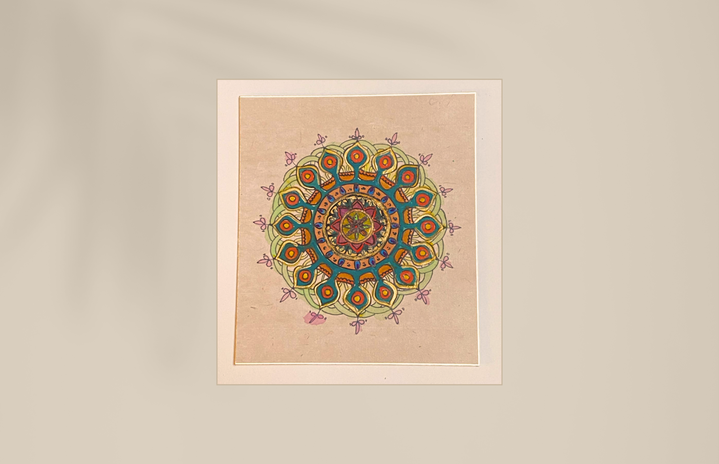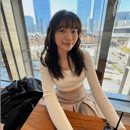“Hey, Rina! Let’s Try to make a Mandala together”
After our 写経 (Shakyou) session at 長谷寺 (Hasedera) in November, my mother excitedly spoke about revisiting Kamakura. We decided to travel after my finals (21 credits this semester. Yes, I know it was over-units, and even though it was a challenge, I enjoyed my classes and found it possible to complete — and so can you if you are considering it☺️) So, after exams, on March 10th, my mother and I attended the Mandala painting experience at “AWAI GALLERY” in Kamakura, Japan, instructed by the Motif Designer Mami Otaki.
What is a Mandala?
In Hindu and Buddhist Tantrism, the Mandala is “a representation of the universe, a consecrated area that serves as a receptacle for the gods and as a collection point of universal forces.” When learning about the Mandala art experience from my mother, my first thought was: “Hmm, I’m not sure if I have the spiritual dedication.” The experience I imagined was the Sand Mandala created by Tibetan monks, which appeared on my YouTube recommendation several months ago. In the video, the Tibetan monks religiously created a Medicine Mandala as “one way of healing the community but also healing the environment” (00:14). I was mesmerized by the beauty of the intricate design created by the monks through hours of prayer and effort. Then, I was surprised at the end to see the monks brushing away the Mandala. The dismantling of the Sand Mandala reflects the Tibetan Buddhist belief that the “sand symbolizes the impermanence of existence.” Expressing that “they do not believe that death is the end. It’s just a passing phase, it’s our essence that carries on. But also that you shouldn’t be attached to anything.” (00:25).
Mandala transcends beyond sand art and encompasses Flower Mandalas and Paint Mandalas, the latter of which I got to experience. Before visiting the gallery, I had not gone looking for examples or done any research on painting Mandalas; all I knew was that it was a form of meditation in Buddhism.
Creating a Paint Mandala on Sakuragami Canvas.
The Motif Designer, Otaki discussed the concept behind her Paint Mandala design, explaining the significance of the center as a representation of our core selves. She encouraged us to express ourselves freely through the Mandala without any distractions.
As Otaki provided us with directions, my mind was already thinking about the aesthetics of my Mandala, which paints to squeeze out, and how to apply them to the canvas. She reminded us not to overthink the colors but to concentrate on the center and choose the color that resonated with us that day. I quickly brushed these thoughts away and thought of the color that resonated with me most that day: Orange.
The instructor asked us to choose between 和紙 (Washi) or 桜紙 (Sakuragami).
She explained that Washi allowed the paint to be easily absorbed and displayed, while Sakuragami absorbed it uniquely, resulting in unexpected color tones. Sakuragami also had a hint of a pink tone and was comparatively rough in texture. Intrigued by the possibility of letting go of my thoughts, I chose Sakuragami and wanted to see how the paper and paint would work together. However, once I started working with the Paint Mandala, I became puzzled by the lack of control I had over my paintbrush, the way the hairs sometimes split apart, and the thickness changing each time I laid it on the canvas.
I focused on the colors, especially my orange. To simply have fun and let go.
I found myself mixing it with other colors like yellow, red, green, and blue. I enjoyed the way these colors interacted with one another. As I reached the outer edges, a feeling of green emerged, leading me to blend blue, yellow, and various colors and eventually come across my favorite shade, teal. With joy, I painted the leaf-shaped area of the Mandala, covering the largest section. When I was brushing, I tried to focus on the roughened texture of the paper and the way the colors seeped through the material; while I am not sure if this was the proper way to meditate for a Mandala, I did feel like it was a soothing color therapy, bringing peace to the mind. Of course, I also encountered a few challenges from the experience that I would like to share.
the Use of Watercolor PainT to embrace the natural flow.
It was not until the instructor pointed it out that I realized I had hesitated to add more water to the paint.
Hence, my Mandala ended up with a thick application of paint, disrupting the natural flow of watercolor on the canvas. Otaki explained that, given the nature of watercolor paint, it was essential to let the water flow. I wondered if I hesitated because I was subconsciously afraid to let the canvas reveal unexpected colors, feeling the need to maintain control. From that point onward, I changed my approach by dipping my brush into the water without squeezing it out, letting it swirl on the paint palette, and then placing it on the canvas. This allowed the water to guide my fingers and mind, creating a more natural and unrestrained flow. It let me see the beauty of accepting the fluidity and spontaneity that comes with the art of Paint Mandala.
Accepting the Flaws of My Mandala.
While applying the thick paint colors to my Mandala, I painted over the design guidelines to the point where they became difficult to see.
Unhappy with the messy appearance, I decided to redraw the lines with a thinner brush, but my lack of familiarity with the tool made it challenging to replicate them. Even after completing the Mandala and being encouraged to connect the design with pens, I remained uncertain about the outcome. The painting seemed careless and disorganized. Surprisingly, my mother and the instructor found the Paint Mandala beautiful and unique, making me happy, but I still couldn’t shake my feelings about it.
Then, it started to make me wonder why I felt the need to adhere to these lines. It occurred to me that it could spring from a desire for the aesthetics I want and a peace of mind (partly influenced by the Tibetan monks’ beautiful Sand Mandalas). However, with its unique colors and messy appearance, my Mandala embodies unpredictability and my flow of thoughts and its paint. Recognizing these flaws has helped me appreciate the beauty in my Paint Mandala’s unpredictability, fluidity and spontaneity.


